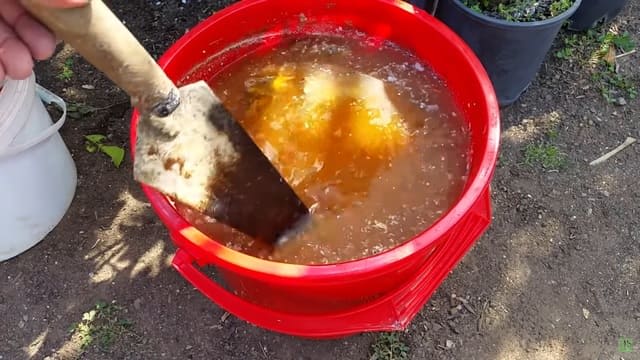In this post, we'll be making nitrogen-rich liquid fertilizer from waste fish with the help of some EM or effective micro-organisms.
If you haven't heard yet more about EM, here is a link to it for later reference:
When our liquid fertilizer is done, there will be little smell. The stuff works quite effectively for boosting the growth of plants. With the amount made in a 20L/5-gallon bucket, you'll have enough fertilizer to use for about a whole year.
Let's see what ingredients we need right now:
Ingredients We Need
- 1L molasses
- 1L EM
- 10L water
- 1 kg or more waste fish
And some tools:
- 20L/5-gal bucket
- Measuring cup
- Wooden/bamboo stick for stirring
For the fish, you can get them from sellers, markets or restaurants with unsold ones for very cheap or often for free. We use fish here for its high nitrogen content. For plant-based protein, you can also use soybean.
If you can't find molasses in your local area, you can replace it with malt syrup or brown sugar.
Remember to use non-chlorine water so it doesn't kill off the microbes.
/preparing-ingredients-making-fertilizer.jpg)
With the ingredients ready, let's get to the making steps next:
Step 1: Mix Molasses + EM + Water
Measure out about 1L molasses and pour it into a 5-gallon/20L bucket. If the molasses is quite thick, add some lukewarm water to dissolve it.
/step-01-mix-em-molasses-water.jpg)
Don't add in all the water just yet, as we'll be adding the fish later on. You'll want to see how much it fills up the bucket, then add the rest of the water accordingly so it doesn't spill.
You can use boiling water to dissolve the molasses quickly. However, remember to let the temperature cool down to about body temperature 37C (98.6F) before adding in the EM. Too hot of a temp may kill the microbes.
Then, when the water is warm enough, you can add in the EM. For mixing, use a non-metal wooden stick to avoid chemical re-actions.
Then, we can add the fish:
Step 2: Add the Fish In
/step-02-add-fish-in.jpg)
After adding the fish in, you can cover the bucket with a grocery bag or plastic cover. This is only for extra protection so houseflies won't come and lay egg inside. Then close the lid.
Let the bucket sit for 30 days in a warm place. After a few days, you can take it out and have a quick sniff. If it has a nice bearable (not stinky at all) aroma, then it's good.
However, if it smells bad then may be something has gone wrong. You can throw the spoiled batch into the soil for composting or get a new batch started.
If all turns out well, we can move on to step 3:
Step 3: Harvest the Fertilizer
After about a month, this is what a done batch looks like:
/step-03-done-fish-fertilizer-nitrogen-batch.jpg)
As you can see, almost all of the fish is gone. The microbes have chewed them to the bone.
The liquid has a golden brown color and a fermented smell like that of fish sauce. To some people though, fish sauce may not have the best smell of them all. But for some others, it is not that bad and is still bearable.
With this liquid fertilizer done, you can dilute it at a 1:100 or 1:200 ratio to spray on plants. For example, for 100 ml of fish EM we can mix it in 10 liters of water. Spraying can be done in the late afternoon when it's cooler to avoid leaf burn.
Give this a try & Hope you'll enjoy. I think this fish EM could be somewhat familiar to FAA or Fish Amino Acids in some Korean Natural Farming methods. Will have a look and try.
For more liquid fertilizer ideas, pls see:
Thanks:
Share or pin this post!


